If you’re trying to choose which size guitar to buy you’ll know it’s not easy. Especially if you’re a beginner and don’t know much, if anything, about guitars.
I was in that position when I first started out. I didn’t know what the right shape or size guitar would be best for me. I wasn’t even sure if it made any difference or how important it was.
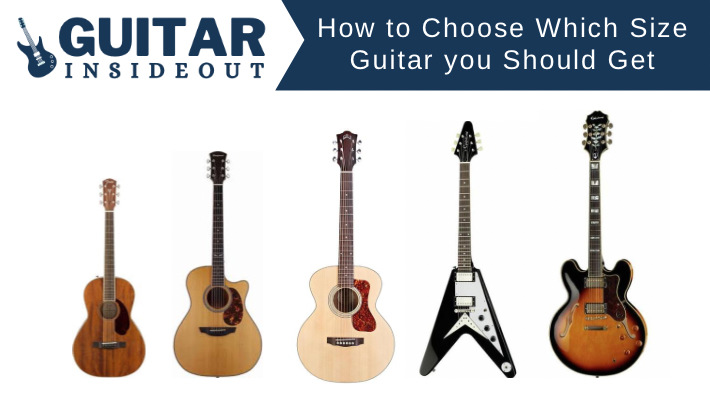
So if you’re struggling with guitar sizes, what they mean and which is right for you then don’t worry. Take a breath and keep reading as this guide will help you to decide which size guitar to get and why.
Types of Guitars and How They Vary in Size
First let’s take a look at the different types of guitars and their sizes.
Acoustic Guitars
Acoustic guitars come in various different sizes. From small travel guitars to grand concerts, jumbo’s and full-size dreadnoughts, you can find an acoustic to fit the smallest or biggest person.
The size of an acoustic guitar is usually measured by the body width at the widest point, the lower bout. This can range from around 13 inches for a parlor guitar (which is usually the smallest type) to around 17 inches for a jumbo.
The depth of the body can also vary. If you’re a smaller player then you may find that a thinner acoustic is more comfortable to play.
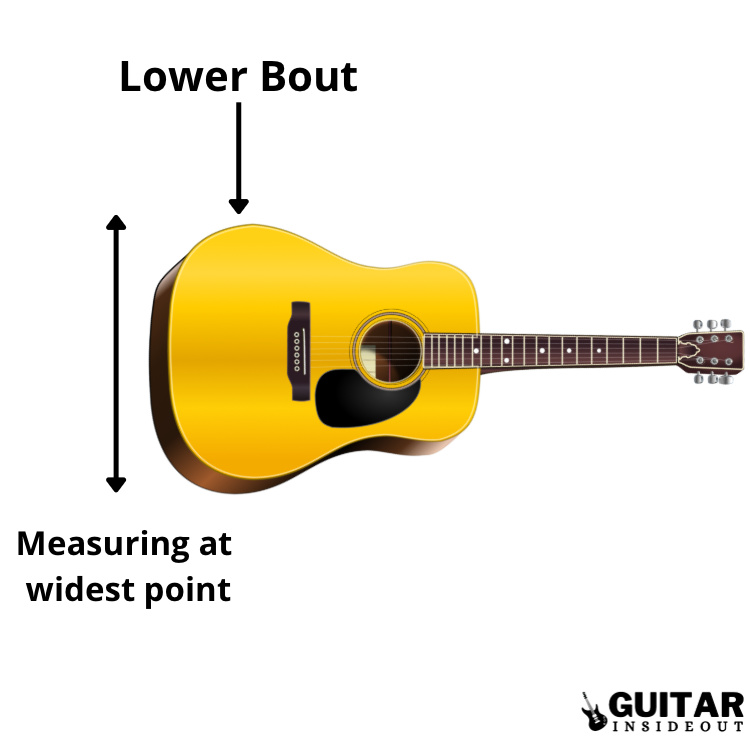
Electric-Acoustic Guitars
Very similar to a regular acoustic guitar except for one major difference – electric-acoustic guitars have a pickup and can be amplified like an electric guitar.
In terms of sizes electric-acoustic guitars and regular acoustic guitars are very alike as apart from the added pickup and electronics they’re identical. So the body of an electric-acoustic guitar is almost always the same size and shape as that of a regular acoustic guitar.
Manufactures want their guitars to sound the same even after the electronics have been added. So as the shape and size of the body has a major impact on how the guitar sounds they aren’t going to change it and have two otherwise identical guitars sounding different to one another.
Having said that there may be some slight differences in the thickness of the guitar body due to where the electronics and controls are placed. On top of that a lot of electric-acoustic guitars have a cutaway for easier access to the higher frets.
But these differences are minimal and the actual physical shape and size of electro-acoustic and regular acoustic guitars is mainly the same.

Washburn Vintage Series 6 String Acoustic-Electric Guitar
Classical Guitars
Classical guitars are usually smaller than regular acoustic guitars as a small body helps to keep the tone softer and more mellow, which is what they’re designed to sound like. A smaller body means reduced bass and increased high frequencies.
You can even get them in smaller sizes (1/2 and 1/4) which are ideally suited for kids. The smaller body also makes them lightweight and easy to hold.

Yamaha C40II Classical Guitar
Electric Guitars
Electric guitars are usually smaller and thinner than acoustic guitars and classical guitars, with a body width of around 12 inches for a solid-body electric guitar. But whereas most acoustic and classical guitars have fairly standard body shapes, even if they come in different sizes, electric guitar bodies come in a big range of shapes.
For example a Stratocaster is probably the shape of guitar that comes to most peoples minds first when they think about an electric guitar. But a Gibson Les Paul is very different in both shape and size.
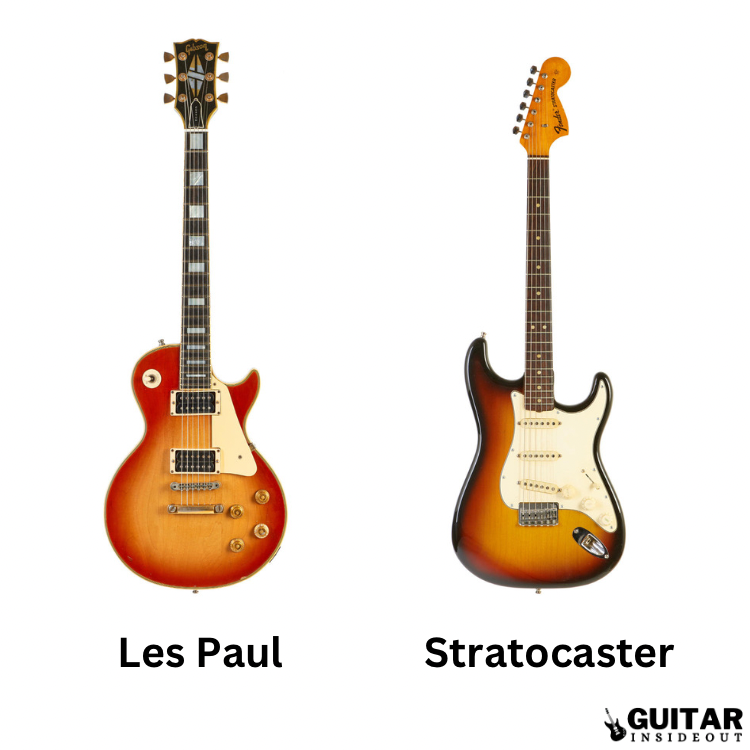
Then within the brands of guitar – Fender, Gibson, Ibanez etc – each model has a very different body shape and size. A Fender Mustang, for example, is much smaller than a Stratocaster. A Gibson SG is much smaller and lighter than a Standard Gibson Les Paul.
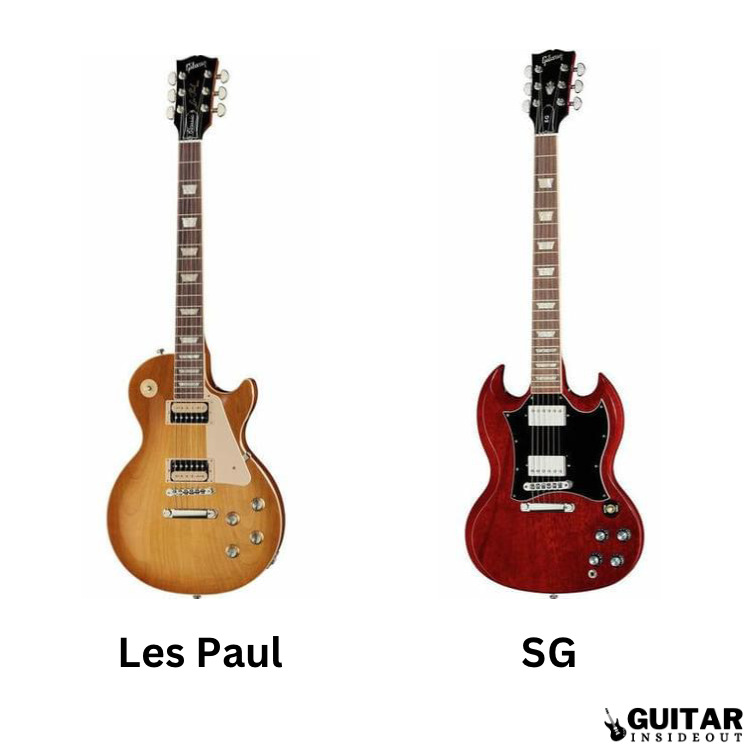
And then there are guitars like Flying V’s, Explorers and more unconventional designs.
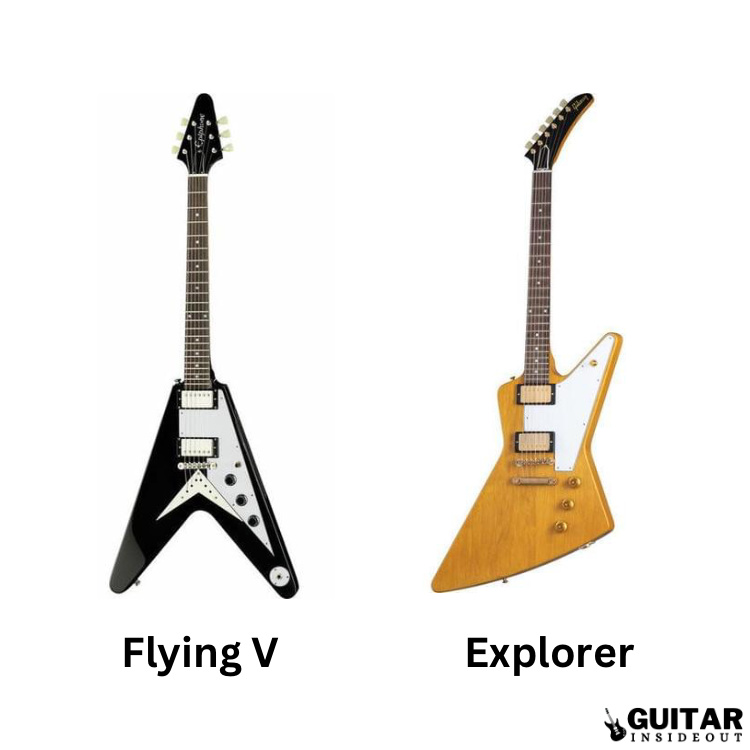
Bass Guitars
Bass guitars tend to have larger bodies than both electric and acoustic guitars. This is due to the strings a bass uses. They are much thicker and heavier than on acoustic and electric guitars and this means they need a larger body in order to produce a full and resonant tone.
There’s also the longer scale length on a bass guitar (which is around 34 inches) that needs a larger body in order to maintain the correct string tension and intonation.
There are of course some variations in the size and shape of bass guitar bodies. With so many different models and manufacturers there will always be some that don’t fit the mould.
For example some bass guitars have a more compact body shape or a different number of strings than a traditional four-string bass, and that can affect the overall size (and weight) of them. But generally bass guitars are larger than other guitars.

Travel Guitars
Travel guitars can be acoustic or electric and are ideal for players who want to practice on the go. They are designed to be compact and portable with a smaller body size and sometimes even a detachable neck.

Body Types
The overall size of the guitar is obviously important. But within each type of guitar there are various body types (and sizes) too. Acoustic guitars have an entire
This is just a quick overview of the most common body types and their size.
Acoustic Guitar Body Sizes
The
Jumbo
Jumbo guitars are the largest of the acoustic guitar sizes. They tend to measure around 21 to 24 inches in length, have a lower bout width of around 17 inches and around 5 inches deep (which makes them deeper than most other acoustic guitars).
Their size gives them a full and deep sound with lots of sustain and resonance. This means they are often used for rhythm playing or fingerstyle and in genres like country, bluegrass and folk where a big and full sound is desired.
However, their size can make them a bit more difficult to play than smaller-bodied guitars. If you have smaller hands or a short reach then you may struggle with a jumbo.

Dreadnaught
Dreadnought’s are one of the most popular acoustic guitar sizes. They have a length of around 20 to 21 inches, a lower bout width (which is the widest part of the body) of around 15 to 16 inches and are around 4.75 inches deep.
Dreadnaughts are large and have quite a distinctive, boxy shape. The body is square-shouldered and has a wide, flat top. This provides a powerful sound with a good midrange and rich bass.
They are often used in genres like country, bluegrass, and folk music where a strong rhythm and percussive strumming are key parts of the style. Similar to jumbo’s the large size can make it a bit more challenging to play, especially for those with smaller hands or a shorter reach. Having said that many guitarists find that the trade-off in sound quality is worth it.

Grand Auditorium
Grand auditorium’s are somewhere in the middle of acoustic guitar sizes. Smaller than jumbo’s and dreadnaughts but still fairly large, they’re a very popular choice.
The body is typically around 20 to 23 inches in length, 16 inches wide at its widest point (the lower bout) and around 4.5 inches deep. That body size allows for a good balance between bass, midrange and treble frequencies.
Grand auditorium guitars are known for being versatile, having a balanced sound and are often described as being well-suited for a variety of playing styles, including strumming, fingerpicking and flatpicking. They tend to have a rich and warm tone which makes them a great choice for both solo and playing with others.

Auditorium
The auditorium guitar, also known as a “000” guitar, is slightly smaller than the grand auditorium. The body is around 19 to 22 inches, has a lower bout width of around 15 inches and is about 4.5 inches deep.
They have a warm and well-balanced tone, with good sustain and projection. Very versatile and can be used for a variety of playing styles, including fingerstyle and flatpicking. They’re also a popular choice for singer-songwriters as they provide a good balance between voice and guitar.
Being that bit smaller in size than a grand auditorium guitar also makes the auditorium more comfortable to play for some.

Grand Concert
Grand concert guitars have a body size that’s smaller than auditorium guitars. Their body length is usually around 18 inches, a width of around 14.5 inches at the lower bout and a depth of around 4 inches.
The smaller body size gives a tighter and more focused sound than larger guitars combined with good projection and sustain. They’re very well-suited to fingerstyle but are also good for strumming or flatpicking.
The small size of the grand concert guitar makes it a comfortable choice, especially for those with smaller hands or who prefer a more compact instrument.

Concert
Also called “folk” or “orchestra” size, concert guitars are smaller than grand concerts. They have a length of around 19 to 20 inches, a lower bout width of around 14 inches and are 4 inches deep.
The concert guitar’s size makes it comfortable to play and its balanced tone makes it well-suited to a variety of genres and styles.

Parlor
Also known as a “travel” or “mini” guitar, parlor’s are the smallest of the acoustic guitar sizes. They typically have a length of 18 to 20 inches, a lower bout width of around 12 inches and 3.5 inches deep.
Due to their small size parlor guitars are often quite boxy and quiet. This makes them better suited to fingerpicking or other more delicate styles of playing.
But the boxier sound is a trade-off many guitarists don’t mind as parlors are small, perfect for travel and easy to play. If you’ve got smaller hands or want an acoustic guitar for a child then a parlor is a good choice.

Electric Guitar Body Sizes
There are far too many different electric guitar body shapes and sizes to go through so let’s just look at a few of the most common.
Solid body
Solid body electric guitars, as their name implies, have a solid body made from wood. They are by far and away the most common type of electric guitar and come in various shapes and sizes.
Some of the most well known are:
- Stratocaster – probably the most famous electric guitar, the Fender Stratocaster has a double cutaway body with rounded edges and a contoured back.
- Telecaster – another classic from Fender, Telecasters have a single cutaway with squared edges and a straight back.
- Les Paul – Gibson’s most well known guitar, the Les Paul has a single-cutaway body shape with a thick and heavy body and a carved maple top.
- SG – Alongside the Les Paul the SG is Gibson’s best known guitar. It has a double-cutaway body shape with pointed horns and a thin, lightweight body.

Hollow body
Hollow body electric guitars have a hollow or semi-hollow body. They have a warm, more resonant sound than solid body’s and are often used in jazz and blues. Common models include:
- ES-335 – sort of like the Stratocaster of hollow body guitars, the ES-335 is the gold standard. It has a semi-hollow body with a center block to reduce feedback and increase sustain.
- Epiphone Casino – Made famous by The Beatles, the Casino has a full hollow body and a bright, jangly sound.
- Archtop – The archtop guitar is a traditional design that dates back to the early 20th century. It has a carved top and back and is often used in jazz and swing music.
Many of the hollow body guitars have large bodies which can be awkward to play, especially if you’re a beginner.

Semi-hollow body
Semi hollow body electric guitars are somewhere between hollow body and solid body guitars.
They take the power and sustain of an electric guitar and combine it with the resonance and warmth you find in hollow body guitars.
Common models include:
- 335-style – similar to the ES-335, these types of guitar have a semi-hollow body and a center block. They’re often used in blues and rock music.
- ES-339 – a smaller version of the ES-335. ES-339’s have a semi-hollow body and a shorter scale length which makes them easier to play.
- Thinline Telecaster – a variation on the classic Telecaster design, a Thinline Telecaster has a semi-hollow body and a bright, twangy sound.

For a more in depth look at this see the guide to every type of electric guitar body shape.
What to Consider When Choosing the Right Guitar Size
When choosing the right size guitar it’s important to consider the type of guitar you want to play, as we’ve just been through above, but also think about how it fits your body size and playing style.
For example if you are quite small or petite or you have short arms then choosing a guitar with a larger body may be uncomfortable. Height, hand size and so on are all factors you need to keep in mind.
Let’s take a look at them all so you know what to look for and think about when trying out different types of guitars to find the one that is the right fit.
Age
Age shouldn’t be the only factor in picking a guitar size but it would be silly to ignore it. If you’re buying a guitar for a child then they’re going to be smaller generally than an adult – smaller hands, fingers, arms etc.
So a small child may need a smaller guitar size that allows them to reach the frets and play comfortably without straining their arms or hands. As a loose rule children under the age of 8 should start with a 1/4 size guitar while older children and adults can usually start with a 1/2 or 3/4 size guitar, depending on their height.
Height
Generally, taller people tend to have longer arms and larger hands. And that’s going to mean they can play a bigger guitar with far fewer issues or difficulty.
But, its not quite as simple as saying ‘shorter people need a smaller guitar’. That’s because the length of the player’s arms and the size of their hands is going to have a much greater impact than their height on how easy or not they find playing a guitar.
Think about it: someone who is tall but has short arms or small hands may still find playing a smaller guitar more comfortable and someone who is shorter but has longer arms and larger hands may like the bigger guitar.
I’m a bit above average height and have really long arms but at the same time have really tiny hands (yes, I’m a bit of freak!). So I don’t have any major problems with larger body guitars but instead have to think about neck size and shape.
Arm Length
As touched on above your arm length can make certain sizes of guitar more or less comfortable. If you have shorter arms you might find it easier to play a smaller guitar, such as a parlor or concert. The smaller bodies of these types of guitars make them easier to reach around and play comfortably.
On the other hand if you have longer arms you may prefer a larger guitar, such as a dreadnought or jumbo. Having bigger bodies like they do can provide more space for your arms and hands to move around while playing.
I’m not saying you need to measure your arms and then find a specific guitar that fits your arm length. That would be weird.
But you probably have an idea of whether you have shorter or longer arms and so you it’s something to keep in mind when trying out various guitars.
Your Body
How big or small your body is can be a factor in choosing a guitar. We’re all different shapes and sizes: thick and thin, long and short etc.
Generally, larger-bodied people will probably feel more comfortable playing a larger guitar while smaller-bodied people may prefer a smaller guitar. A 6ft 5″ mountain of a man trying to learn on a tiny parlor acoustic is going to struggle (and look ridiculous).
And the obvious physical differences between men and women is something to consider too. Most guides like this will be coming from the perspective of a man, and I’m in slightly awkward territory here as not being a woman I can’t really comment on what a women needs or should be looking for.
But it’s worth mentioning that if you are a woman/girl then you may have different requirements or find you aren’t comfortable with guitars that men are. Sadly there aren’t many options designed specifically with women in mind, although that is changing. It also doesn’t mean you’ll struggle with regular guitars.
From a personal perspective and in terms of body size I’m definitely on the slimmer and small-bodied end of the scale. So while I don’t struggle with arm length my smaller build means I can find larger acoustic guitars a bit too big and overwhelming.
But, as with height, the more important factor in choosing the size of a guitar is not necessarily body size but rather the arm length and hand size.
Playing Style
The size of guitar shouldn’t come before the style of music you want to play. For example – you’re a huge fan of of rock music and that’s the reason for your deciding to learn the guitar.
So you will need an electric guitar. But you’re worried that an electric is too big for you. So instead you’re going to get a classical or small acoustic because you think it’ll be easier.
That’s not going to work. If you can’t play the style and genres of music you like on your guitar chances are you won’t pick it up much.
When I started out I knew for sure that if I only had a nylon string classical I would have given up. Why? Because I wanted to play rock music! A classical simply wasn’t going to let me do that.
So if it comes down to the size of the guitar vs the style of music you want to play then the latter wins, hands down.
Scale Length is Important
When you think about the size of a guitar you probably assume we’re talking about the length from one end to the other.
But that’s not a good way to look at guitar sizes. Why?
Because it takes into account the headstock which varies in so many models and types of guitar. And the headstock has no impact on how it will feel to play.
What you should be focusing on is the scale length. Scale length is measured from the bridge of the guitar to its nut.
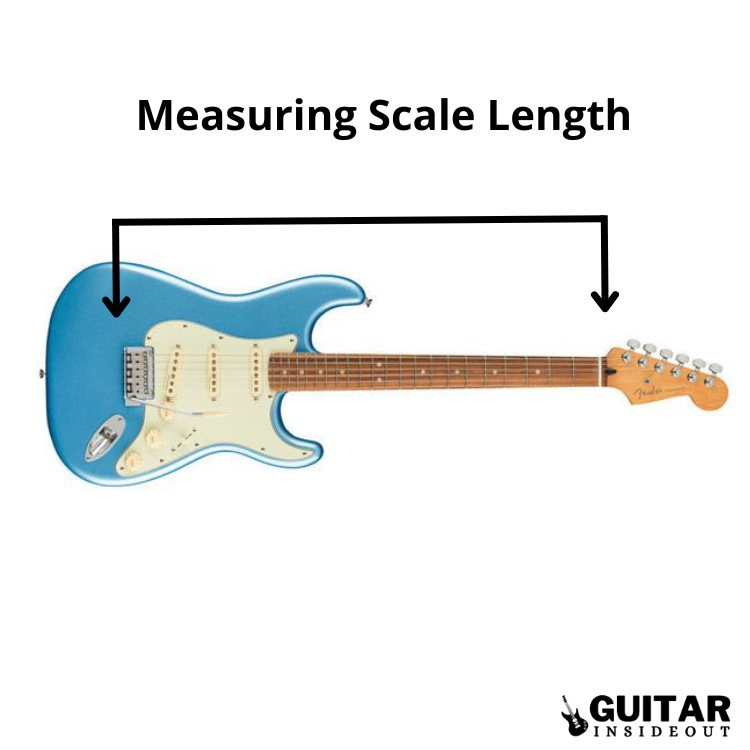
It really reflects the length of the neck and that makes a big difference in how the guitar will feel. Quite often beginners or those with shorter arms prefer a shorter scale length because they find it easier to play.
There are a lot of good options for shorter scale guitars. Fender have the Mustang, Jaguar and Duo Sonic which are all short scale electric guitars and may be easier to play if you have short arms, small hands or find bigger bulkier guitars awkward.
The Fender Squier Mustang is a phenomenal guitar for such an affordable price and probably the best electric guitar for beginners, regardless of scale length or size.
- Affordable
- Good for small hands
- Sounds great
- Lightweight
As for acoustic guitars I currently have a Taylor GS Mini which has shorter scale than the regular and is slightly smaller than most acoustics. I love it and find it the perfect guitar for just picking up and strumming when sat in front of the TV.
Sadly it isn’t as well priced as the Mustang but it’s a wonderful guitar I fully recommend.
Guitar Size Chart
This shouldn’t be something you follow as an absolute rule, the below guitar size chart should help you to choose a guitar based on age me height:
As already stated these are just general guidelines and may not apply to every player. It’s not an exact science and you’re much better off trying out different different sized guitars to see which one feels most comfortable and suits you.
And it’s important to remember that some guitar manufacturers may use different sizing conventions. So make sure you check the actual measurements of the guitar rather than relying on what the manufacturer claims.
Above all else you want to find a guitar that fits your body size and feels comfortable to play for long periods of time. If that happens to be a guitar that is bigger or smaller than you might have expected or than the chart above shows then that’s fine! It’s all about whatever you enjoy playing.
How do You Know it’s the Right Size?
The most obvious answer to whether it’s the right size for you is: does it feel comfortable. If so then it should be fine.
But most beginners find holding a guitar uncomfortable or awkward at first regardless of the size or model. It’s something they’ve never done before and need to get used to.
So instead you should check a few things:
- Can you reach the fists frets? It will probably feel uncomfortable if you’re a beginner but it’s very important you be able to reach and wrap your fingers around the neck at the first fret. If not then that guitar is too big for you.
- How does it feel with your arm and hand over the body of the guitar? Can you comfortably move them around the bridge or sound hole, depending on the type of guitar. If not then it may be too wide or chunky body and you will want to look for a slimmer guitar.
- How does it feel when you stand up? Most people make the mistake of only playing sitting down. But it’s always a good idea to play a little standing too. If the guitar is too heavy or awkward to reach any parts when standing then that’s another sign it’s not the guitar for you.
Trying Out Guitars
I can’t emphasise it enough – you need to try a guitar in person before buying it! I know we can order pretty much everything online now but a guitar is one of the few things that it’s still best to buy having felt and tried it out first.
Even more so if you’re a newbie. You’ve got to pick the guitar up, sit with it and feel how comfortable it is.
Guitar stores can be intimidating, especially if you’ve never played before or aren’t very good. But having the chance to sit and try multiple guitars and find the one that really feels best is so important.
Lots of online shops like Amazon and Sweetwater will allow you to return a guitar free of charge.
And that’s great because if you don’t like it then you haven’t lost any money. But if you do it that way then you lose the opportunity to compare different models.
I’ll be honest – I’ve bought guitars online without ever having played them. And for the most part I’ve got away with it.
But it think that’s partly because I knew what I wanted and I had a lot experience of having played and owed many guitars. If I was buying my first guitar or had never played a certain type or model then I would definitely recommend trying them out in person.
Tips for Trying Guitars
These are a few tips for trying out guitars:
- Plan ahead: don’t go to the store without having an idea of the type of guitar you want, the style of music you’re going to play, your budget etc. Do some research of the different brands and models that you might be interested in and you could even make a list of the guitars you want to try out.
- Be open minded: even if you have an idea of the model or type of guitar you think you want try to keep an open mind. So often the guitar you have your heart set on turns out not to feel right and it’s the one you would never have considered that ends up being the perfect choice. So don’t pre-judge and be open to every brand or model.
- Ask for assistance: if you’re not that familiar with guitars or a complete beginner then don’t be afraid to ask a salesperson for help. Let them know what you are looking for and they can offer some suggestions and help.
- Take your time: Don’t rush when trying out guitars. You want to spend enough time with each one to get a feel for it and see if it’s the right fit for you. Play it but also just sit with it. Take in how it feels and whether you will be comfortable holding it.
- Ask questions: If you have any questions about any of the guitars you try then don’t hesitate to ask the salesperson. They should be able to provide you with any additional information you need about the guitar’s features and specifications.
- Trust your instincts: What it comes do though is how the guitar feels to you. If you find a guitar that feels comfortable and easy to play, and you like the sound of it, then it’s probably going be the right one for you.
Trying out guitars can be intimidating. Even with years of experience I still feel awkward playing in a guitar store.
But do your best to enjoy it and try to remember how exciting it is that you could be coming away with the guitar of your dreams.
Difference Between Full-Size and 3/4 Size Guitars
One of the most common choices when it comes to guitar size is between a full-size guitar and a 3/4 size guitar. I’ll be completely honest – I don’t like 3/4 guitars.
I can understand for some children they’re necessary. You can’t always expect a tiny child to be able to handle a full size electric or acoustic.
But for adults I don’t think they’re a good idea. They don’t sound right to me and encourage bad habits.
When the adult eventually wants to take that step up to a proper, full sized guitar then they struggle. They find they’re having to relearn aspects and fight bad techniques they’ve learnt because of the smaller size.
And there’s no real need for an adult to use a 3/4 size guitar. A fully grown adult should be able to hold a regular sized guitar without any problems. Especially when you consider how many various guitar shapes and sizes there are.
But if you are thinking of getting one, hopefully for a child, then the main difference between the two sizes are:
- Size and Weight: you could probably guess this but a full size guitar is larger and heavier than a 3/4 size guitar. That’s the main part of their appeal – they are well suited for a child or younger player who hasn’t yet developed the necessary strength and dexterity to hold a full size guitar.
- Fret Spacing: On a 3/4 size guitar the space between the frets is closer together than on a full size guitar. Again, for a child with small hands this can help when reaching and making chords. But for anyone with normal sized hands it is going to be cramped and awkward.
- Sound: A full size guitar has a fuller and more robust sound than a 3/4 size guitar. They have better resonance and sustain due to their larger size. To me 3/4 guitars just sound flat and weak.
Online Guitar Shopping
If you can’t get to a music or guitar store in person or if you prefer shopping online then there are loads of online guitar retailers. However you should keep a few things in mind when shopping for a guitar online:
- Research: researching the guitar you’re interested in is super important. Check out reviews, look on YouTube, go through the specifications like weight and size etc.
- Look for a reputable dealer: don’t use a website that you haven’t heard of! Buying from a reputable store or dealer is the only way you can be sure you don’t get ripped off. So make the website is secure and that whoever you use has a good reputation for its customer service.
- Check the return policy: Make sure you can return the guitar if it’s not the right size or if it arrives damaged. Most online retailers offer this as an option now but it’s best to confirm it first just in case.
- Be prepared to make adjustments: new guitars often need to be adjusted to either play well or fit your playing style and preferences. This may include adjusting the action, the neck or the intonation. If you’re not comfortable making these adjustments yourself then take the guitar to a professional guitar tech or luthier.
At the end of the day if I was being completely honest this whole article could have been summed up in one sentence: go to a guitar store and try out a whole bunch guitars to see which feels right. That’s the best way to find out which guitar size suits you best.
I hope some of the information provided here has helped you make a better decision or be more prepared when you do visit a shop. Remember to be open minded about all types of guitar, if buying for a child look at 1/2 or 3/4 sizes, consider shorter scale lengths, and pick a guitar that makes you want to play!

